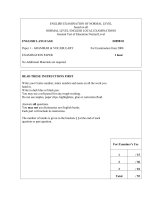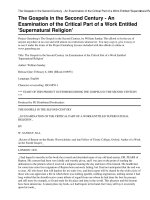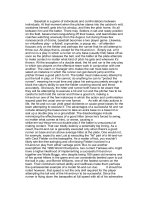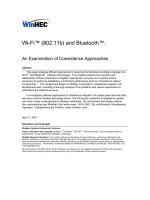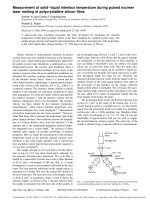Surface tension examination of various liquid oral, nasal, and ophthalmic dosage forms
Bạn đang xem bản rút gọn của tài liệu. Xem và tải ngay bản đầy đủ của tài liệu tại đây (916.58 KB, 5 trang )
Han et al. Chemistry Central Journal (2016) 10:31
DOI 10.1186/s13065-016-0176-x
Open Access
RESEARCH ARTICLE
Surface tension examination of various
liquid oral, nasal, and ophthalmic dosage forms
Kimberly Han, Osakpolor E. Woghiren and Ronny Priefer*
Abstract
Surface tension at the surface-to-air interface is a physico-chemical property of liquid pharmaceutical formulations
that are often overlooked. To determine if a trend between surface tension and route of administration exists, a suite
of oral, nasal, and ophthalmic drug formulations were analyzed. The surface tension at the surface-to-air interface of
the oral formulations studied were in or above the range of the surface tension of gastric, duodenum, and jejunum
fluids. The range of surface tensions for oral formulations were 36.6–64.7 dynes/cm. Nasal formulations had surface
tensions below that of the normal mucosal lining fluid with a range of 30.3–44.9 dynes/cm. Ophthalmic OTC formulations had the largest range of surface tensions at the surface-to-air interface of 34.3–70.9 dynes/cm; however, all
formulations indicated for treatment of dry eye had surface tensions higher than that of normal tears, while those for
treatment of red eye had surface tensions below. Therefore, surface tension at the surface-to-air interface of liquid
formulations is dependent on the route of administration, environment at site of introduction, and for ophthalmics,
what the formulation is indicated for.
Background
Liquid drug delivery systems undergo extensive experimental testing beyond pharmacodynamic and pharmacokinetic studies, such as pH, viscosity, density, stability,
leachable studies, isotonicity, etc. A parameter that is
often overlooked is surface tension at the surface-to-air
interface. This is more understandable for oral or parenteral liquid dosage forms since they are quickly distributed in the physiological aqueous media of the body.
However, for ophthalmic and nasal formulations, which
have much greater interaction with the air, this knowledge may have a greater impact on efficiency of the delivery of the drug. Surface tension is derived from a liquid’s
elastic tendency. The layer of molecules on the surface
attempt to minimize their overall surface area by being
attracted to molecules in the bulk liquid. It is well known
that surface tension is considered a critical parameter in
other areas with significant liquid–air exposures, such as
spray dryer, [1] fuel injection, [2] childhood interstitial
lung diseases (chILD), [3] as well as by us recently in the
*Correspondence:
College of Pharmacy, Western New England University, Springfield,
MA 01119, USA
determination of the pKa values of polymers [4] . The surface tension of ophthalmic and nasal formulations affects
the rate of its evaporation, the interaction with the lacrimal film of tears or the airway mucosal lining, as well
as how easily it would spread along a biological surface.
To minimize irritation one would expect that liquid formulations in general would mimic the natural surface
tension of the particular area of administration and thus
maximize interactions. At the onset of this study we had
anticipated that the surface tension at the surface-to-air
interface for ophthalmic and nasal formulations would be
in a very narrow range centered near that of body’s physiological environment and that oral formulations would
have a much broader range of surface tensions. Herein,
we report our findings on the surface tensions at the surface-to-air interface for a range of oral, nasal, and ophthalmic over-the-counter (OTC) drug substances.
Experimental part
Kaopectate® Max (Chattem Inc), CareOne™ Regular
Strength Stomach Relief (Foodhold USA, Inc), CareOne™
Loperamide HCl Oral Suspension (Foodhold USA, Inc),
Children’s Delsym® Cough + Cold Nitetime (Reckitt
Materials
© 2016 The Author(s) This article is distributed under the terms of the Creative Commons Attribution 4.0 International License
( which permits unrestricted use, distribution, and reproduction in any medium,
provided you give appropriate credit to the original author(s) and the source, provide a link to the Creative Commons license,
and indicate if changes were made. The Creative Commons Public Domain Dedication waiver ( />publicdomain/zero/1.0/) applies to the data made available in this article, unless otherwise stated.
Han et al. Chemistry Central Journal (2016) 10:31
Page 2 of 5
Benckiser), Chloraseptic® Sore Throat (Medtech Products
Inc), CareOne™ Multi-Symptom Nitetime Cold/Flu Relief
(Foodhold USA, Inc), CareOne™ Non-Drowsy Daytime
Cold/Flu Relief (Foodhold USA, Inc), CareOne™ Infants’
Ibuprofen Oral Suspension (Foodhold USA, Inc), Halo™
Oral Antiseptic (Oasis Consumer Healthcare, LLC), Concentrated Motrin®’s Infants’ Drops (McNeil Consumer
Healthcare), Afrin® No Drip Extra Moisturizing (MSD
Consumer Care, Inc), Afrin® Original Nasal Spray (MSD
Consumer Care, Inc), CareOne® No Drip Nasal Spray
(American Sales Co), Zicam® Intense Sinus Relief No
Drip Liquid Nasal Gel (Matrixx Initiatives, Inc), Mucinex®
Sinus-Max (Reckitt Benckiser), 4 Way® Nasal Decongestant Fast Acting Spray (Novartis Consumer Health, Inc),
Vicks® Sinex 12 Hour Decongestant Nasal Spray (Procter
& Gamble), NeoSynephrine® Cold & Sinus Mild Strength
Spray (Bayer HealthCare LLC), CareOne® Saline Nasal
Spray—Nasal Moisturizing Spray (American Sales Co),
Vicks® Non-Drowsy Qlear Quil 12 Hour Nasal Decongestant Moisturizing (Procter & Gamble), TheraTears® Lubricant Eye Drops (Advanced Vision Research, Inc), Refresh®
Liquigel Lubricant Eye Gel (Allergan, Inc), Refresh® Optive
Lubricant Eye Drops (Allergan, Inc), Systane® Ultra High
Performance (Alcon Laboratories, Inc), Systane® Gel
Drops Anytime Protection (Alcon Laboratories, Inc), Clear
Eyes® Contact Lens Multi-Action Relief, Systane® Balance
Restorative Formula (Alcon Laboratories, Inc), Visine-A®
Multi-Action Allergy Relief (Johnson & Johnson Healthcare Products), Clear Eyes® Redness Relief (Medtech Products Inc), and CareOne™ Sterile Eye Drops (American Sales
Co) were all freshly purchased from a local pharmacy, were
non-expired, and used as is. Where multiple containers
were need it was ensured that identical lots were employed.
Surface tension determination
Surface tension at the surface-to-air interface was measured at room temperature in sextuplicate using a surface
tensiometer (CSC-DuNOÜY, Central Scientific Co, Inc)
with a 6 cm platinum tensiometer ring (Thomas Scientific). Using the correction Eq. (1), actual surface tension
values were obtained.
(F − a)2 = 4b/(π R)2 × P/(D − d) + K
(1)
where F = the correction factor; R = the radius of
the ring; r = the radius of the wire of the ring; P = the
apparent value or dial reading; D = the density of
the lower phase; d = the density of the upper phase;
K = 0.04534 – 1.679 r/R; C = the circumference of the
ring; a = 0.7250; b = 0.0009075.
Results and discussion
At the onset, we would like to make clear that the objective of this non-externally funded study is not to report
on which drug formulation is “better” nor on which surface tension at the surface-to-air interface is “optimal”
for any class of drug. To ensure this, no surface tension
measurements were compared to their respective manufacturers’ reported values, if available. Furthermore, no
grandiose conclusions were made regarding the efficacy
of the formulations studied. We choice a du Noüy ring
tensiometer for measuring the surface tension at the
surface-to-air interface for this study. Briefly, a platinum
ring is lowered into a solution that is being analyzed until
completely submerged. Upon pulling the ring up and
out of the solution, the force needed to ultimate break
contact of the ring to the solution is measured. We initially began by exploring various oral formulations. We
selected 10 OTC products with a range of pharmacological activity. Indications for the formulations studied
include: pain/fever relief, anti-diarrheal, decongestant,
antiseptic, antihistamine, indigestion, etc. CareOne™
brands were our most commonly utilized product line,
not by design but rather by necessity as they had the
widest range of OTC products available at the local
pharmacy. We hypothesized that the surface tension at
the surface-to-air interface of oral formulations would
have a large range, since, upon clinical administration
of the medication, the liquids would be quickly distributed throughout the significantly large volume of the GI
tract. The surface tension at the surface-to-air interface at
room temperature of the gastric fluids in the fasting state
have been reported to be in the range of 31–45 dynes/cm
(medium of 36.8 dynes/cm), [5] which is very similar to
that of the duodenal fluids of ~37 dynes/cm [6, 7]. Jejunal
fluids have been reported to have a slightly lower surface
tension of ~30.5 dynes/cm [5]. This lowering of surface
tension has been hypothesized to be due to decreased
secretion of bile salts from the gall bladder compared to
the duodenum (~2.5 mM compared to ~3.3 mM, respectively) [5]. There is a reported lowering of surface tension
for all intestinal fluids in the fed state to 30.5 [5, 7], 31.3
[3, 5] and 30.0 dynes/cm, [8] for gastric, duodenal, and
jejunal fluids respectively. In contrast, deionized water
has a surface tension of 72.2 dynes/cm [9]. Since the
reported surface tension of the fluids in the GI tract were
determined at room temperature, the oral OTC formulations were also done at that temperature. It is known that
as temperature increases, surface tension decreases. For
example with deionized water there is a drop in surface
tension from 71.99 to 70.41 dynes/cm as the temperature is increased from 25 to 35 °C [10]. All ten of the oral
OTC formulations examined had surface tensions at the
surface-to-air interface greater than the surface tension
of the GI fluids at the fed state, and with one exception,
above the fasting state (Table 1). Motrin®’s Infant Drops
had the lowest surface tension of the formulations we
Han et al. Chemistry Central Journal (2016) 10:31
Page 3 of 5
Table 1 Surface tension at the surface-to-air interface for oral OTC formulations
Solution
Indication
Kaopectate® Max
Anti-diarrheal, relives nausea and upset stomach associated with diarrhea
64.7 ± 0.1
Antihistamine for allergic reactions, motion sickness, cold, itching, nausea/
vomiting, sleep aid
59.6 ± 0.6
CareOne™ Regular Strength Stomach Relief
CareOne™ Loperamide HCl Oral Suspension
Children’s Delsym® Cough + Cold Nitetime
Surface tension
(dynes/cm)
Anti-diarrheal, traveler’s diarrhea
57.8 ± 0.7
Cough, nasal congestion, symptoms of hay fever (sneezing, runny nose
and itchy watery eyes)
49.0 ± 0.6
Chloraseptic® Sore Throat (Phenol/Oral Anesthetic) Upset stomach (indigestion/heartburn), anti-diarrhea, nausea, belching
CareOne™ Multi-Symptom Nitetime Cold/Flu Relief Pain/fever reducer, cough suppressant, antihistamine
44.6 ± 0.2
CareOne™ Infants’ Ibuprofen Oral Suspension
Pain/fever reducer, cough suppressant, antihistamine
41.3 ± 0.2
Pain and fever reducer
39.0 ± 0.7
Concentrated Motrin®’s Infants’ Drops
Oral antiseptic
37.6 ± 0.4
Relieves fever and minor aches/pain due to common cold
36.6 ± 0.6
CareOne™ Non-Drowsy Daytime Cold/Flu Relief
Halo™ Oral Antiseptic
41.5 ± 0.1
Gastric fluid
~36.8 fasting ~30.5 fed
Duodenum fluid
~37 fasting ~31.3 fed
Jejunum fluid
~30.5 fasting ~30.0 fed
tested, at 36.6 dynes/cm. The formulation with the highest surface tension, at 64.7 dynes/cm, was the antidiarrheal, Kaopectate® Max. Non-electrolytes dissolved in an
aqueous solution tend to lower the surface tension at the
surface-to-air interface. Thus, it was not surprising that
all formulations examined were below 72.2 dynes/cm.
Compared to the other oral formulation, Kaopectate®
Max, CareOne™ Loperamide Hydrochloride, and CareOne™ Regular Strength Stomach Relief had the greatest
surface tension values, and of those tested were the only
three that contained derivatized cellulose. The most commonly employed excipient in the oral formulations were
glycerin (7 liquids), propylene glycol (4 liquids), and polyethylene glycol (3 liquids). These have surface tensions
of 63.4, 40.1, and 44.0 dynes/cm, [11] respectively, which
partially explains the lowered surface tensions. Nonetheless, the range of surface tensions at the surface-to-air
interface for the oral formulations examined was between
36.6 and 64.7 dynes/cm, or a difference of 28.1 dynes/cm.
For nasal formulations, we again selected 10 OTCs
from a range of manufacturers. Not surprising, most
were nasal decongestant, whether for allergies or treating
symptoms of the common cold. The normal surface tension of the upper airway mucosal lining liquid has been
reported to be ~56 dynes/cm [12]. The temperature of
the upper airway has been reported to be slightly higher
than room temperature at ~30 °C [13]. This would only
produce a difference of <1 dyne/cm hence our study was
conducted at room temperature. All the nasal formulations had a surface tension at the surface-to-air interface lower than the surface tension of the upper airway
mucosal lining liquid (Table 2). The lower the surface tension of a solution, the less intermolecular forces present,
which in turn enables it to wet a surface more readily.
Similar to the oral formulations discussed above, some
nasal solutions contained glycerin, derivatized cellulose, propylene glycol, and/or polyethylene glycol, all of
which would lower the surface tension relative to deionized water. One ingredient that was found in all 10 nasal
OTCs was benzalkonium chloride (BAC). This is typically
added as a preservative, however it also a surface active
agent (i.e., a cationic surfactant) [11]. The surfactant may
be serving multiple roles in the formulation. Beyond a
preservative, it could be increasing the solubility of the
active agent, as well as allowing for the formation of
micelles [11]. The latter requires that the amount of BAC
added be above the critical micelle concentration (CMC).
Although the quantities used in the nasal formulations
are not specified, the allowable range of BAC in nasal formulations, by USP 34-NF 29 standards, is 0.002–0.02 %
w/v, which could allow for micelle formation since the
CMC of BAC is 0.0035 % w/v [14]. Regardless of micelle
formation or not, the addition of the cationic surfactant
lowers the surface tension at the surface-to-air interface. The lower surface tension of the nasal formulations
allows for easier spreading over the surface, and therefore
increase drug distribution and absorption.
We had initially hypothesized that the surface tension at
the surface-to-air interface for ophthalmic solutions would
have the narrowest range and be very similar to that of
normal tears (~43 dynes/cm) [15]. The temperature of the
cornea has been reported to be only slightly higher than
room temperature at <29 °C [16]. We were surprised that
not only were the surface tension values of many of the
ten ophthalmic OTCs substantially different than normal
tears (Table 3), the range of the surface tensions was also
Han et al. Chemistry Central Journal (2016) 10:31
Page 4 of 5
Table 2 Surface tension at the surface-to-air interface for nasal OTC formulations
Solution
Indication
Surface tension
(dynes/cm)
~56
Mucosal lining fluid
Afrin® No Drip Extra Moisturizing
Afrin® Original Nasal Spray
CareOne® No Drip Nasal Spray
Zicam® Intense Sinus Relief No Drip Liquid Nasal Gel
Mucinex® Sinus-Max
4 Way® Nasal Decongestant Fast Acting Spray
Vicks® Sinex 12 Hour Decongestant Nasal Spray
NeoSynephrine® Cold & Sinus Mild Strength Spray
CareOne® Saline Nasal Spray—Nasal Moisturizing Spray
Vicks® Non-Drowsy Qlear Quil 12 Hour Nasal Decong.
Moisturizing
Relieves nasal congestion due to common cold, hay fever, upper
respiratory allergies; swollen nasal membranes, sinus congestion/
pressure
44.7 ± 0.8
Relieves nasal congestion due to common cold, hay fever, upper
respiratory allergies; swollen nasal membranes, sinus congestion/
pressure
41.6 ± 0.3
Relieves nasal congestion; sinus congestion
40.6 ± 0.4
Relieves nasal congestion due to common cold, hay fever, allergies,
and sinusitis; sinus congestion/pressure
37.4 ± 0.6
Relieves nasal congestion, due to common cold, hay fever, upper
respiratory allergies; sinus congestion/pressure
37.2 ± 0.4
Relieves nasal congestion, sinus congestion/pressure, swollen nasal
membranes
36.7 ± 0.4
Relieves nasal congestion due to cold, hay fever, upper respiratory
allergies
33.9 ± 0.2
Relieves nasal congestion due to cold, allergies
33.8 ± 0.2
Relieves dry nasal membranes
33.1 ± 0.2
Relieves nasal congestion due to cold, hay fever, other respiratory
allergies; sinus congestion/pressure
30.3 ± 0.2
Table 3 Surface tension at the surface-to-air interface for ophthalmic OTC formulations
Solution
TheraTears® Lubricant Eye Drops
Indication
Surface tension (dynes/cm)
Used to moisten dry eyes and also to relieve burning sensation, irritation and discomfort caused by dry eyes
70.9 ± 0.2
Refresh® Optive Lubricant Eye Drops
Used for moderate to severe dry eye symptoms
66.4 ± 0.2
Used to relieve dry, irritated eyes. Decreases symptoms such as irritation, burning
65.6 ± 0.2
Systane® Gel Drops Anytime Protection
Used to relieve dry, irritated eyes. Decreases symptoms such as irritation, burning
61.0 ± 0.3
Refresh® Liquigel Lubricant Eye Gel
Systane® Ultra High Performance
Used to relieve dry, irritated eyes. Decreases symptoms such as irritation, burning
Clear Eyes® Contact Lens Multi-Action Relief Relieves dry eyes, rewets lenses, soothes and moisturizes, removes particles from
lenses
Systane® Balance Restorative Formula
For the temporary relief of burning and irritation due to dryness of the eye
Clear Eyes® Redness Relief
CareOne™ Sterile Eye Drops
46.5 ± 0.4
~44
Tears
Visine-A® Multi-Action Allergy Relief
54.3 ± 0.6
54.1 ± 0.2
Temporarily relieves itchy, red eyes due to: pollen, ragweed, grass, animal hair and
dander
39.5 ± 0.2
Relieves redness of the eye due to minor eye irritations
37.1 ± 0.2
Relief of redness and irritation of the eye
34.3 ± 0.2
greater than for both the nasal or oral formulations. This
was initially perplexing, however, when grouped into liquids for the treatment of the symptoms of either dry eye
or red eye, a pattern emerged. All the formulations that are
indicated for red eye: Clear eyes® Redness relief, VisineA® Multi-Action Eye Allergy Relief, and CareOne™ Sterile
Eye Drops, contain a vasoconstrictor, α-adrenergic agent,
naphazoline hydrochloride or tetrahydrozoline hydrochloride, which would lower the aqueous surface tension.
None of the other ophthalmic drops contain a small molecule drug. As is the case for nasal sprays, a surface tension
lower than that of the environment in which the solution is
being introduced is beneficial to ensure greater spreading
and thus absorption of the drug. In addition, the lowering
of the surface tension of the ophthalmic solutions was partially due to the use of a surfactant, more accurately, BAC.
Recently it has been reported that the introduction of BAC
into human tears hinders the ability of native lipids to
spread across the tear films and can result in the replacement of those lipid with BAC molecules [17]. It has been
suggested that this phenomenon has a negative impact on
the tear film stability [17].
Han et al. Chemistry Central Journal (2016) 10:31
All ophthalmic OTCs tested that are indicated for dry
eye have surface tensions at the surface-to-air interface
above the value for tears. The three ophthalmic solutions
with the greatest surface tension at the surface-to-air
interface are: Thera® Tears Lubricant Eye Drops, Refresh
Liquigel®, and Refresh Optive® Lubricant Eye Drops,
with values of 70.9, 66.4, and 65.6 dynes/cm, respectively.
These three were the only solutions tested that contained
the active ingredients, sodium carboxymethylcellulose,
which is used to lubricate the eye. In addition to this
macromolecule salt, all three solutions contained numerous other electrolytes that contribute to higher surface
tension values. Of the three products Refresh Optive®
Lubricant Eye Drops has the lowest surface tension. It is
the only one of the three that contains glycerin, which is
known to lower the surface tension values. The remaining four ophthalmic OTCs are all indicated for dry eye,
and have surface tension values at the surface-to-air
interface above the surface tension of tears and were in
the range of 46.5–61 dynes/cm. The lubricants present
in these four solutions are polyethylene glycol, propylene
glycol, and/or glycerin.
Conclusions
All OTC formulations tested had surface tensions at the
surface-to-air interface less than that of deionized water.
For oral formulations, there was a broad range of surface
tensions, however each was at or above the surface tensions of gastric, duodenum, and jejunum fluids. For nasal
formulations, all solutions had surface tension beneath
the mucosal lining fluids. This allows for greater spreading of the formulation on the surface. For ophthalmic formulations, solutions indicated for treatment of red eye
had surface tensions less than that of tears, presumably
to allow for greater spreading. Ophthalmic solutions that
were indicated for treatment of dry eye had surface tensions greater than that of tears, most likely to increase the
stability of the tear film and thus allow for greater lubrication of the eye.
Authors’ contributions
KH and OEW carried out the surface tension measurements. RP conceived of
the study, and participated in its design and coordination and helped to draft
the manuscript. All authors read and approved the final manuscript.
Acknowledgements
Acknowledgment is made to Western New England University College of
Pharmacy for financial support. RP would also like to thank Prof. Shabnam N.
Sani for helpful discussions.
Competing interests
The authors declare that they have no competing interests.
Page 5 of 5
Received: 10 March 2016 Accepted: 28 April 2016
References
1. Breinlinger T, Hashibon A, Kraft T (2015) Simulation of the influence of
surface tension on granule morphology during spray drying using a
simple capillary force model. Powder Technol 283:1–8
2. Dernotte J, Hespel C, Houille S, Foucher F, Mounaim-Rousselle C (2012)
Influence of fuel properties on the diesel injection process in nonvaporizing conditions. Atomization Spray 22:461–492
3. Whitsett JA, Wert SE, Trapnell BC (2004) Genetic disorders influencing
lung formation and function at birth. Hum Mol Genet 13:207–215
4. Dickhaus BN, Priefer R (2016) Determination of polyelectrolyte pKa values
using surface-to-air tension measurements. Colloids Surf A 488:15–19
5. Bergström CAS, Holm R, Jørgensen SA, Andersson SBE, Artursson P, Beato
S, Borde A, Box K, Brewster M, Dressman J, Feng K-I, Halbert G, Kostewicz
E, McAllister M, Muenster U, Thinnes J, Taylor R, Mullertz A (2014) Early
pharmaceutical profiling to predict oral drug absorption: current status
and unmet needs. Eur J Pharm Sci 57:173–199
6. Clarysse S, Tack J, Lammert F, Duchateau G, Reppas C, Augustijns P (2009)
Postprandial evolution in composition and characteristics of human
duodenal fluids in different nutritional states. J Pharm Sci 98:1177–1192
7. Kalantzi L, Goumas K, Kalioras V, Abrahamsson B, Dressman JB, Reppas
C (2006) Characterization of the human upper gastrointestinal contents
under conditions simulating bioavailability/bioequivalence studies.
Pharm Res 23:165–176
8. Persson E, Gustafsson A-S, Carlsson A, Nilsson R, Knutson L, Forsell P,
Hanisch G, Lennernäs H, Abrahamsson B (2005) The effects of food on
the dissolution of poorly soluble drugs in human and in model small
intestinal fluids. Pharma Res 22:2141–2151
9. Heller W, Cheng M-H, Greene BW (1966) Surface tension measurements
by means of the “microcone tensiometer”. J Colloid Interf Sci 22:179–194
10. Vargaftik NB, Volkov BN, Voljak LD (1983) International tables of the
surface tension of water. J Phys Chem Ref Data 12:817–820
11. Rowe RC, Sheskey PJ, Quinn ME (2009). In: Handbook of pharmaceutical
excipients, 6th edn. Pharmaceutical Press, Grayslake, pp 283–286 (glycerin), pp 517–522 (polyethylene glycol), pp 592–594 (propylene glycol)
pp 56–58 (benzalkonium chloride)
12. Kirkness JP, Madronio M, Stavrinou R, Wheatley TC (2005) Amis, Surface
tension of upper airway mucosal lining liquid in obstructive sleep apnea/
hypopnea syndrome. Sleep 28:457–463
13. Sériès F, Marc I (1998) Upper airway mucosa temperature in obstructive
sleep apnoea/hypopnoea syndrome, nonapnoeic snorers and nonsnorers. Eur Respir J 12:193–197
14. Kato Y, Yagi H, Kaji Y, Oshika T, Goto Y (2013) Benzalkonium chloride
accelerates the formation of the amyloid fibrils of corneal dystrophyassociated peptides. J Biol Chem 288:25109–25118
15. Tiffany JM, Winter N, Bliss G (1989) Tear film stability and tear surface tension. Curr Eye Res 8:507–515
16. Mirnezami SA, Jafarabadi MR, Abrishami M (2013) Temperature distribution simulation of the human eye exposed to laser radiation. J Lasers Med
Sci 4:175–181
17. Georgiev JA, Yokoi N, Koev K, Kutsarova E, Ivanova S, Kyumurkov A,
Jordanova A, Krastev R, Lalchev Z (2011) Surface chemistry study of the
interaction of benzalkonium chloride with films of meibum, corneal cell
lipids, and whole tears. Invest Ophth Vis Sci 52:4645–4654
